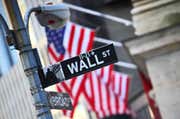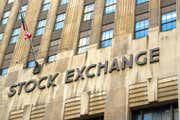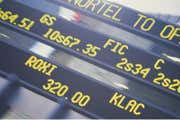We saw in the last section that once a company completes an initial public offering (IPO), its shares become public and can be traded on a stock market. Stock markets are venues where buyers and sellers of shares meet and decide on a price to trade. Some exchanges are physical locations where transactions are carried out on a trading floor, but increasingly the stock exchanges are virtual, composed of networks of computers where trades are made and recorded electronically.
Stock markets are secondary markets, where existing owners of shares can transact with potential buyers. It is important to understand that the corporations listed on stock markets do not buy and sell their own shares on a regular basis (companies may engage in stock buybacks or issue new shares, but these are not day-to-day operations and often occur outside of the framework of an exchange). So when you buy a share of stock on the stock market, you are not buying it from the company, you are buying it from some other existing shareholder. Likewise, when you sell your shares, you do not sell them back to the company – rather you sell them to some other investor.
The first stock markets appeared in Europe in the 16th and 17th centuries, mainly in port cities or trading hubs such as Antwerp, Amsterdam, and London. These early stock exchanges, however, were more akin to bond exchanges as the small number of companies did not issue equity. In fact, most early corporations were considered semi-public organizations since they had to be chartered by their government in order to conduct business.
In the late 18th century, stock markets began appearing in America, notably the New York Stock Exchange (NYSE), which allowed for equity shares to trade (the honor of the first stock exchange in America goes to the Philadelphia Stock Exchange [PHLX], which still exists today). The NYSE was founded in 1792 with the signing of the Buttonwood Agreement by 24 New York City stockbrokers and merchants. Prior to this official incorporation, traders and brokers would meet unofficially under a buttonwood tree on Wall Street to buy and sell shares.
The advent of modern stock markets ushered in an age of regulation and professionalization that now ensures buyers and sellers of shares can trust that their transactions will go through at fair prices and within a reasonable period of time. Today, there are many stock exchanges in the U.S. and throughout the world, many of which are linked together electronically. This in turn means markets are more efficient and more liquid.
There also exists a number of loosely regulated over-the-counter exchanges, sometimes known as bulletin boards, that go by the acronym OTCBB. OTCBB shares tend to be more risky since they list companies that fail to meet the more strict listing criteria of bigger exchanges. For example, larger exchanges may require that a company has been in operation for a certain amount of time before being listed, and that it meets certain conditions regarding company value and profitability. In most developed countries, stock exchanges are self-regulatory organizations (SROs), non-governmental organizations that have the power to create and enforce industry regulations and standards. The priority for stock exchanges is to protect investors through the establishment of rules that promote ethics and equality. Examples of such SRO’s in the U.S. include individual stock exchanges, as well as the National Association of Securities Dealers (NASD) and the Financial Industry Regulatory Authority (FINRA).
The prices of shares on a stock market can be set in a number of ways, but most the most common way is through an auction process where buyers and sellers place bids and offers to buy or sell. A bid is the price at which somebody wishes to buy, and an offer (or ask) is the price at which somebody wishes to sell. When the bid and ask coincide, a trade is made.
[Want to start trading stocks? Check out Investopedia's online stock broker reviews.]
Some stock markets rely on professional traders to maintain continuous bids and offers since a motivated buyer or seller may not find each other at any given moment. These are known as specialists or market makers. A two-sided market consists of the bid and the offer, and the spread is the difference in price between the bid and the offer. The more narrow the price spread and the larger size of the bids and offers (the amount of shares on each side), the greater the liquidity of the stock. Moreover, if there are many buyers and sellers at sequentially higher and lower prices, the market is said to have good depth. Stock markets of high quality generally tend to have small bid-ask spreads, high liquidity, and good depth. Likewise, individual stocks of high quality, large companies tend to have the same characteristics.
In addition to individual stocks, many investors are concerned with stock indices (also called indexes). Indices represent aggregated prices of a number of different stocks, and the movement of an index is the net effect of the movements of each individual component. When people talk about the stock market, they often are actually referring to one of the major indices such as the Dow Jones Industrial Average (DJIA) or the S&P 500.
The DJIA is a price-weighted index of 30 large American corporations. Because of its weighting scheme and that it only consists of 30 stocks – when there are many thousand to choose from – it is not really a good indicator of how the stock market is doing. The S&P 500 is a market cap-weighted index of the 500 largest companies in the U.S., and is a much more valid indicator. Indices can be broad such as the Dow Jones or S&P 500, or they can be specific to a certain industry or market sector. Investors can trade indices indirectly via futures markets, or via exchange traded funds (ETFs), which trade like stocks on stock exchanges. (See also: Opinion: Dow 20,000 Is Stupid.)
Stocks Basics: Trading Stocks and Order Types
-
 Investing
InvestingStock Exchanges: A Global Tour
Check out the history and inner workings of the world's six most well-known stock exchanges. -
 Investing
InvestingA Look At Primary And Secondary Markets
Knowing how the primary and secondary markets work is key to understanding how stocks, bonds and other securities are traded. -
 Investing
InvestingStock Exchanges Around The World
We tell you about five of the most popular stock exchanges from around the globe. -
 Trading
TradingTake A Tour Of The Futures Trading Pit
Discover why controlled chaos can mean an exciting investment experience for you. -
 Investing
InvestingIndex Investing
Get to know the most important market indices and the pros and cons of investing in them. -
 Investing
InvestingHow To Calculate The Bid-Ask Spread
It's very important for every investor to learn how to calculate the bid-ask spread and factor this figure when making investment decisions. -
 Trading
TradingAn Introduction To Securities Markets
The global securities market is constantly evolving. Discover the most popular market structures currently in use. -
 Insights
InsightsTips For Face-to-Face Buying And Selling
Be aware of these dangers when buying or selling goods in person. -
 Investing
InvestingPlaying hardball when selling your home
Are you planning on selling your house? Learn these strategies to help you get you a better deal in house sale. -
 Investing
InvestingFinancial markets: Capital vs. Money Markets
There are several key differences between capital markets and money markets as components of financial markets. Check out the similarities and differences between the two markets.



